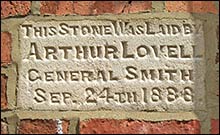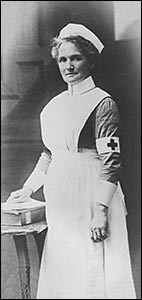 |
|
An Arthur Lovell undated
|
Mr. Arthur Lovell, of Higham Ferrers, began work at the age of eleven. He celebrated his diamond wedding anniversary on Tuesday, but at the age of 83 he still hopes to do some more work as a blacksmith. Unfortunately he was knocked down by a car last year, fractured a leg, and is obliged to go gently at present.
To an "Echo and Argus" representative who called at 2, Hind Style, Higham Ferrers, where they live happily near the smithy, Mr. and Mrs. Lovell told their story.
Mrs. Lovell is 82, and before marriage was Miss Jane Bailey, of Grendon. The wedding was at Higham Parish Church, the Rev. E. Templeman, then Vicar of Higham, officiating.
Mr. Lovell was born at Higham in 1853, and educated by Mr. Sanderson and the late Rev. Malim. He was apprenticed to the trade of blacksmith under the late Mr. James Carter, who had a smithy at Higham Ferrers. He started his apprenticeship when he was 11 years old, and served 5½ years for the princely sum of 1s. 6d. a week.
Blacksmith at 17
Mr. Lovell then went as an improver to the shoeing smithy at Stanwick, which was owned by the late Mr. Partridge. When he was about 17 years of age he joined the foundry at Hargrave as a blacksmith, under the late Mr. J. L. Baker, a civil engineer and the maker of Baker's famous double plough. After six years at Hargrave he came back to Higham and took over his old employer's shop where he was first apprenticed. The smithy at this time stood where the Higham Working Men's Club now stands.
 |
|
The stone on the building next to the Post Office in Saffron Road
|
Earl Fitzwilliam, who owned nearly the whole of the town in 1888, had a new smithy erected at the back of No. 2, "Hind Style," where it stands to-day.
Mr. Lovell laid a foundation stone, and it is inscribed:—
"This stone was laid by Arthur Lovell, general smith, September 24th, 1888."
When Earl Fitzwilliam sold a considerable amount of his property, Mr. Lovell purchased the smithy, and also the house, and the shop nearby, which was owned by the late Mr. J. Noble, a tinsmith.
Two chestnut trees planted in 1888 by Mr. Lovell near his blacksmith's shop have now grown to a good size and give the smithy an old-world atmosphere.
"A good blacksmith is the most useful man in the country" declared Mr. Lovell, who recalled that they used to work from 5a.m. to 8p.m., and added: "I am more of an engineer, though I am a practical shoeing smith, I made between five and six tons of shoes for the Army during the War, and had four men helping me."
He shoed horses and repaired agricultural implements for the farmers in the district for 30 or 40 years, and is proud of the fact that if he was asked to make a Baker's plough, he would be able to make one now.
Although Mr. Lovell has been concerned mainly with the shoeing of horses and the repair of farming equipment, he has made several ''penny-farthing" bicycles for a number of people in the town." He rode one of the "old bone-shaker" bicycles, with wooden wheels, and one of the first motor tricycles, a fore-runner of the modern motor cycle. He has attended several of the Mayoral banquets, and remembers when fairs used to be held in the streets. He also remembers when there were toll gates in use in the district, and you had to pay toll when you entered Higham and when you left it.
 |
 |
|
Mrs Jane Lovell in her
VAD uniform
|
Mr & Mrs Lovell with the letter from
the King and Queen
|
Mrs. Lovell went out to work when she was six years old, and before she was ten years of age she was in service at Grendon House. She was a member of the household staff of the Lord Mayor of Nottingham when the bridge over the River Trent was opened, and during in the War she was a cook in the Higham Ferrers V.A.D. Hospital. Besides holding this position she assisted with the nursing.
They have had nine sons, all of whom are now living and married except one, William Lovell, who died in Africa during the War. Another son, George, is in Aberdeen, South Dakota, U.S.A. Three of their sons, Cyril, Edgar and William, served in the Royal Engineers during the War. There are 15 grandchildren and two great-grandchildren.
Mr. and Mrs. Lovell are very proud of a letter they received on Tuesday from the King and Queen at Buckingham Palace.
"The King and Queen have heard with much interest that you and Mrs. Lovell are celebrating your diamond wedding day to-morrow and desire me to convey to you their hearty congratulations and good wishes for a very happy anniversary."
|